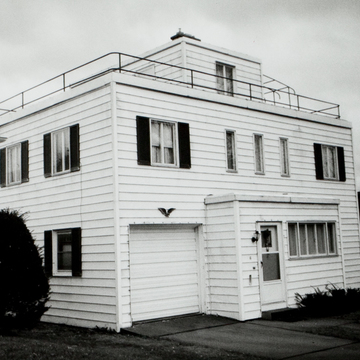The story behind this unusual house is as unusual as its appearance. The Wheeling Corrugating Company, famous for “Wheeling ceilings,” constructed it during the Depression as an experiment to determine the feasibility of entering the prefabricated housing market. The foundations are masonry, the floors are wood over a smooth steel deck, and the interior walls are plastered on steel lath. Practically all other components, including framing, pipes, plumbing, lath, and ceilings (of course), are steel. All of the parts were fabricated at the factory and assembled on site.
Exterior walls are rolled steel plates, covered with porcelain enamel, similar to those that the Lustron Corporation would use a decade later (see WH55). According to Architectural Forum, which described the house in its November 1933 issue, the architects, from Cleveland, decided to finish the house with a “make-or-break use of color”: “On a body of medium gray certain panels and pilasters will stripe upward in blue-gray. The cornice pieces will add two horizontal lines of dark red, and the steel window subframes are to be gray-green with the sashes painted white.” It was probably not the “makeor-break” color scheme that prevented the company from building other houses, but the project's timing at the height of the Depression, which could hardly have been worse. In addition, the rectangular, flat-roofed building with a recessed third floor had a boxy, rigidly uncompromising appearance that did not have universal appeal among potential homeowners. Current owners have tried to make the house less formidable by adding white vinyl siding, a few shutters, and a bronze eagle. Still, the overall shape confirms that something unusual lurks not far beneath the surface.














